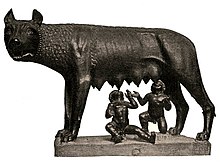Lycaon (Arcadia)
From Wikipedia, the free encyclopedia
For the Trojan Lycaon, see Lycaon (Troy).
In Greek mythology, Lycaon (/laɪˈkeɪɒn/; Greek: Λυκάων) was a king of Arcadia, son of Pelasgus and Meliboea, who, in the most popular version of the myth, tested Zeus by serving him the roasted flesh of his son Nyctimus, in order to see whether Zeus was truly omniscient. In return for these gruesome deeds, Zeus transformed Lycaon and his offspring into the forms of a wolf; Nyctimus was restored to life.
Lailoken
From Wikipedia, the free encyclopedia
Lailoken was a semi-legendary madman and prophet who lived in the Caledonian Forest in the late 6th century. The Life of Saint Kentigern mentions "a certain foolish man, who was called Laleocen" living at or near the village of Peartnach (Partick) within the Kingdom of Strathclyde. Laleocen prophesied the death of King Rhydderch Hael.
As a wild man and seer living in the forests of what is now southern Scotland, Lailoken is often identified with Myrddin Wyllt, the Welsh forerunner of the Arthurian wizardMerlin. Myrddin is particularly associated with the Battle of Arfderydd in Cumberland (now Cumbria) and the area just to the north, over the border in modern Scotland; Myrddin fought for the losing side and, after the battle, went insane. There was also a late 15th-century story Lailoken and Kentigern which states: "...some say he was calledMerlynum".
Romulus and Remus
From Wikipedia, the free encyclopedia
Romulus /ˈrɒmjᵿləs/ and Remus /ˈriːməs/ were the twin brothers and main
characters of Rome's foundation myth. (The pronunciation in
English is different from the Latin original Rōmulus and Rĕmus).
According to Roman tradition, of which Livy's account is now the
earliest to survive in full, their mother was Rhea Silvia,
daughter of Numitor,
king of Alba Longa. Before their conception, Numitor's brotherAmulius seized
power, killed Numitor's male heirs and forced Rhea Silvia to become a Vestal Virgin,
sworn to chastity.
Rhea Silvia conceived the twins by the god Mars.
Once the twins were born, Amulius had them abandoned to die in the Tiber river. They
were saved by a series of miraculous interventions: the river carried them to
safety, a she-wolf found and suckled them, and a woodpecker fed
them.A shepherd and his wife found
them and fostered them
to manhood as simple shepherds. The twins, still ignorant of their true
origins, proved to be natural leaders. Each acquired many followers. When they
discovered the truth of their birth, they killed Amulius and restored Numitor
to his throne. Rather than wait to inherit Alba Longa, they chose to found a
new city.





No comments:
Post a Comment